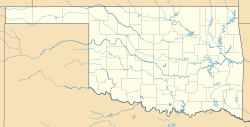Mardock Mission facts for kids
Quick facts for kids |
|
|
Mardock Mission
|
|
| Nearest city | Stella, Oklahoma |
|---|---|
| Area | less than one acre |
| Built | 1898 |
| NRHP reference No. | 83002081 |
| Added to NRHP | March 14, 1983 |
The Mardock Mission was a historic building in Mardock, Oklahoma. It was built way back in 1898. This special place was a meetinghouse for many years.
The mission was added to the National Register of Historic Places in 1983. This means it's an important historical site. It's special because it's the only building left that shows the history of the Big Jim Band of Absentee Shawnee Indians. It also tells the story of Quaker missionaries and a group of people who wanted social changes before World War I.
Contents
What Was the Mardock Mission?
The Mardock Mission was located in a small village called Mardock. This village was in Cleveland County, Oklahoma. At one time, Mardock had a post office, two stores, and a cotton gin.
The Absentee Shawnee People
The Absentee Shawnee were a group of Native Americans. They were called "Absentee" because they left the rest of their tribe in Kansas in 1845. They settled along the Canadian River in what was then called Indian Territory.
Big Jim was an important chief of the Absentee Shawnee. He was the grandson of the famous leader Tecumseh. In 1904, there were about 454 people in the Big Jim Band.
A Place for Learning and Community
In 1897, a group called the Maine Branch of the Women's National Indian Association started the mission. They wanted it to be a school for the Native Americans. It was also a place for religious gatherings and to try out new farming methods.
They built buildings, planted an orchard, and grew crops. Around 1898 or 1899, the mission was given to another group. This group was called the Associated Executive Committee of Friends. They continued to run the mission. John T. Mardock was in charge, and the land was given to him.
Life at the Mission
The Big Jim Band of Shawnee people were open to farming and community activities. However, they were not as interested in changing their traditional beliefs. Even so, the mission kept going. In the early 1900s, it also started helping the growing number of white settlers in Mardock.
Many activities happened at the mission. There were Bible talks and evening meetings. People would sing and play games together. During berry season, they would pick and sell berries. Farmers also had monthly meetings there. Even in 1929, about 35 Native American farmers still attended these meetings.
The mission was also a meeting spot for the Jones Family. This group was involved in a movement for social change during World War I. Some people believe they were part of the Green Corn Rebellion in 1917. Young members of the group were advised to avoid joining the army.
The Mission's Later Years
After 1929, the main mission activities slowed down. However, the mission church building continued to serve the local white community. It was used until about 1955, when the settlement of Mardock was abandoned.
The property was then sold to a local farmer. He used the old church building to store hay. Later, a missionary named Rev. Ted Reynolds repaired the church. He used it for a short time to help the Big Jim Band.
The Building's Appearance
In 1982, the church was nominated to be on the National Register of Historic Places. At that time, it was empty. It was the only building left from the original mission property.
The Big Jim Mission building was a small, one-story structure. It was shaped like a "T" and had wooden siding. The roof was steeply sloped and pointed. The main entrance had a porch with a pointed roof and decorative brackets. There was a diamond-shaped window on the front of the building. Single windows were on four sides, and pairs of windows were on three sides. A brick chimney was on the east side. Thick bushes and many trees surrounded the building. Some changes were made to the outside, like partly filling in two windows.



